George Sinclair, 7th Earl of Caithness
Last updatedGeorge Sinclair | |
|---|---|
| Earl of Caithness | |
 Earl of Caithness Coat of Arms | |
| Predecessor | John Campbell |
| Successor | John Sinclair, 8th Earl of Caithness |
| Died | 1698 |
| Noble family | Clan Sinclair |
| Father | Francis Sinclair of Northfield |
George Sinclair, previously of Keiss, died 1698, was a Scottish nobleman, 7th Earl of Caithness and chief of the Clan Sinclair, a Scottish clan of the Scottish Highlands.
Contents
Early life
George Sinclair of Keiss was the son of Francis Sinclair of Northfield, who in turn was a younger son of George Sinclair, 5th Earl of Caithness. His first cousin-once-removed was George Sinclair, 6th Earl of Caithness (d. 1676) who was the son of John Sinclair, Master of Berriedale and his wife Jean, daughter of Colin Mackenzie, 1st Earl of Seaforth. The 6th Earl of Caithness's paternal grandparents were William Sinclair, Lord Berriedale and Mary, daughter of Henry Sinclair, Lord Sinclair. William Sinclair, Lord Berriedale was in turn the elder son of George Sinclair, 5th Earl of Caithness. [1]
Dispute to the Earldom of Caithness
George Sinclair, 6th Earl of Caithness married Mary, daughter of Archibald Campbell, 1st Marquess of Argyll, but had no children. He died at Thurso Castle in 1676. The Earldom of Caithness being much in debt, he had transferred the estates and the title to his principal creditor, John Campbell of Glenorchy, who upon Sinclair's death was created Earl of Caithness by patent. This however was challenged by George Sinclair of Keiss. On 13 July 1680, Campbell of Glenorchy took a force of 800 men north to evict Sinclair of Keiss, who was waiting for him with 500 men near Wick. Inflamed with drink, the Sinclairs attacked the force of Campbells and were routed in what is known as the Battle of Altimarlach. Legend has it that so many Sinclairs were killed that the Campbells were able to cross the river without getting their feet wet. [2] [3] However, in 1681 the Privy Council of Scotland made a proclamation in favour of Sinclair of Keiss who became the 7th Earl of Caithness and Campbell of Glenorchy was created Earl of Breadalbane and Holland by way of compensation. [1] [4] [5]
George Sinclair of Keiss, 7th Earl of Caithness died in 1698 without issue and this brought an end to the male heirs of the 5th Earl. The Earldom of Caithness then devolved upon the male heirs of James Sinclair, 1st of Murkle, [1] who himself was a son of John Sinclair, Master of Caithness (d. 1576), who in turn was a son of George Sinclair, 4th Earl of Caithness (d. 1582). [6] John Sinclair, eldest son of James Sinclair, 2nd of Murkle, then became the 8th Earl of Caithness. [1] [5]
See also
Related Research Articles
William Sinclair (1410–1480), 1st Earl of Caithness (1455–1476), last Earl (Jarl) of Orkney, 2nd Lord Sinclair and 11th Baron of Roslin was a Norwegian and Scottish nobleman and the builder of Rosslyn Chapel, in Midlothian.

Earl of Caithness is a title that has been created several times in the Peerage of Scotland, and it has a very complex history. Its first grant, in the modern sense as to have been counted in strict lists of peerages, is now generally held to have taken place in favor of Maol Íosa V, Earl of Strathearn, in 1334, although in the true circumstances of 14th century, this presumably was just a recognition of his hereditary right to the ancient earldom/mormaership of Caithness. The next year, however, all of his titles were declared forfeit for treason.

Lord Sinclair is a title in the Peerage of Scotland. According to James Balfour Paul's The Scots Peerage, volume VII published in 1910, the first person to be styled Lord Sinclair was William Sinclair, 3rd Earl of Orkney and 1st Earl of Caithness. However, according to Roland Saint-Clair writing in the late 19th century, William Sinclair's father, Henry II Sinclair, Earl of Orkney, who died in 1420, is the first person recorded as Lord Sinclair by public records.
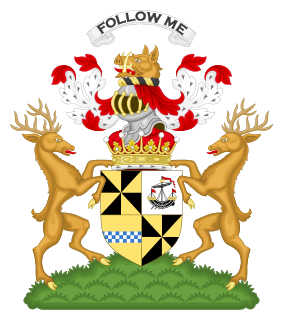
Earl of Breadalbane and Holland is a title in the Peerage of Scotland. It was created in 1681 for Sir John Campbell, 5th Baronet, of Glenorchy, who had previously been deprived of the title Earl of Caithness. He, as a principal creditor, had acquired the estates of George Sinclair, 6th Earl of Caithness who had died heavily in debt and without issue in 1670. Campbell was consequently created Earl of Caithness in 1673, but after much litigation and even bloodshed, George Sinclair of Keiss, second son of George, 5th Earl of Caithness, recovered the estates, and successfully petitioned parliament regarding the earldom, which was removed from Campbell. Sinclair's title was finally restored to him in 1681. Deprived by parliament of the Caithness earldom, Sir John Campbell was created Lord Glenorchy, Benederaloch, Ormelie and Weick, Viscount of Tay and Paintland, and Earl of Breadalbane and Holland on 13 August 1681, with the precedency of the former patent and with the power to nominate any of his sons by his first wife to succeed him. The titles were created with remainder to the heirs male of the son chosen to succeed him, failing which to the heirs male of his body, failing which to his own heirs male, failing which to his heirs whatsoever. The "of Holland" part of the title derived from the fact that Campbell was the husband of Lady Mary Rich, daughter of Henry Rich, 1st Earl of Holland.

Clan Sutherland is a Highland Scottish clan whose traditional territory is the shire of Sutherland in the far north of Scotland. The chief of the clan was also the powerful Earl of Sutherland, however in the early 16th century this title passed through marriage to a younger son of the chief of Clan Gordon. The current chief is Alistair Sutherland who holds the title Earl of Sutherland.
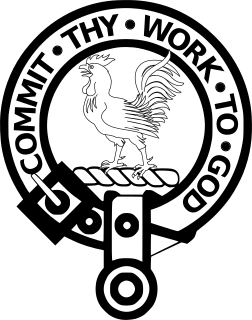
Clan Sinclair is a Highland Scottish clan who held lands in Caithness, the Orkney Islands, and the Lothians. The chiefs of the clan were the Barons of Roslin and later the Earls of Orkney and Earls of Caithness. The Sinclairs are believed to have come from Normandy to England during the Norman conquest of England, before arriving in Scotland in the 11th century. The Sinclairs supported the Scottish Crown during the Scottish–Norwegian War and the Wars of Scottish Independence. The chiefs were originally Barons of Roslin, Midlothian and William Sinclair, 1st Earl of Caithness and Baron of Roslin founded the famous Rosslyn Chapel in the 15th century. He split the family lands, disinheriting his eldest son from his first marriage, William, who inherited the title of Lord Sinclair, instead giving the lands of Caithness to the second son from his second marriage, William Sinclair, 2nd Earl of Caithness, in 1476, and the lands at Roslin to his eldest son from his second marriage, Sir Oliver Sinclair. In the 16th century the Sinclairs fought against England during the Anglo-Scottish Wars and also feuded with their neighbors the Clan Sutherland. During the Jacobite rising of 1715 the Sinclairs supported the Jacobite cause, but during the Jacobite rising of 1745, while the clan largely had Jacobite sympathies, their chief, the Earl of Caithness, supported the British-Hanoverian Government. The current chief is Malcolm Sinclair, 20th Earl of Caithness.

Castle Sinclair Girnigoe is located about 3 miles north of Wick on the east coast of Caithness, Scotland. It is considered to be one of the earliest seats of Clan Sinclair. It comprises the ruins of two castles: the 15th-century Castle Girnigoe; and the early 17th-century Castle Sinclair. They are designated as a scheduled monument.
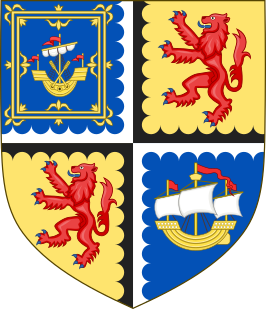
William Sinclair was a nobleman, the 2nd Earl of Caithness and chief of the Clan Sinclair, a Scottish clan of the Scottish Highlands.
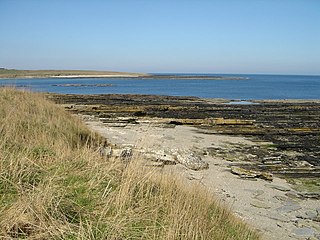
Murkle (Murchill) is a small scattered hamlet, made up of East Murkle and West Murkle located one mile (1.6 km) east of Thurso, in Caithness, Scottish Highlands and is in the Scottish council area of Highland.

John Sinclair was a Scottish nobleman, 3rd Earl of Caithness and chief of the Clan Sinclair, a Scottish clan of the Scottish Highlands.
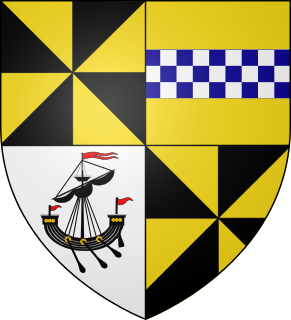
The Battle of Altimarlach was a Scottish clan battle that took place on 13 July 1680, near Wick, Caithness, Scotland. It was fought in a dispute between Sir John Campbell of Glenorchy and George Sinclair of Keiss over who had the right to the title and lands of the Earl of Caithness. The battle was fought between men of the Clan Campbell and Clan Sinclair. Campbell of Glenorchy won a decisive victory in the battle, but Sinclair of Keiss later turned to the law and was awarded the title of Earl of Caithness.
John Sinclair, 11th Earl of Caithness was a Scottish noble, Earl of Caithness and chief of the Clan Sinclair, a Highland Scottish clan.
James Sinclair, 12th Earl of Caithness was a Scottish noble, Earl of Caithness and chief of the Clan Sinclair, a Highland Scottish clan.

George Sinclair was a Scottish nobleman, the 4th Earl of Caithness and chief of the Clan Sinclair, a Scottish clan of the Scottish Highlands.
John Sinclair, Master of Caithness was a Scottish nobleman and chief of the Clan Sinclair, a Scottish clan of the Scottish Highlands.

George Sinclair was a Scottish nobleman, the 5th Earl of Caithness and chief of the Clan Sinclair, a Scottish clan based in northern Scotland.

George Sinclair was a Scottish nobleman, 6th Earl of Caithness, and chief of the Clan Sinclair, a Scottish clan of the Scottish Highlands.

John Sinclair was a Scottish nobleman, 8th Earl of Caithness and chief of the Clan Sinclair, a Scottish clan of the Scottish Highlands.
Alexander Sinclair, 9th Earl of Caithness was a Scottish nobleman, Earl of Caithness and chief of the Clan Sinclair, a Highland Scottish clan in Caithness.

William Sinclair was a Scottish nobleman and the 3rd Lord Sinclair. In The Scots Peerage by James Balfour Paul he is designated as the 2nd Lord Sinclair, but historian Roland Saint-Clair designates him the 3rd Lord Sinclair in reference to his descent from his grandfather, Henry II Sinclair, Earl of Orkney, the first Lord Sinclair. Roland Saint-Clair references this to an Act of the Scottish Parliament in which William Sinclair's son, Henry Sinclair, 4th Lord Sinclair, was made Lord Sinclair based on his descent from his great-grandfather, Henry II Sinclair, Earl of Orkney, the first Lord Sinclair. Bernard Burke, in his a Genealogical and Heraldic Dictionary of the Peerage and Baronetage of the British Empire, agrees with Roland Saint-Clair and says that Henry Sinclair was "in reality" the fourth holder of the title of Lord Sinclair.
References
- 1 2 3 4 Henderson, John W.S (1884). Caithness Family History. Edinburgh: David Douglas. pp. 7-9.
- ↑ Anderson, William (1862). The Scottish nation: or, The surnames, families, literature, honours, and biographical history of the people of Scotland. Vol. 1. Fullarton. pp. 524–525.
- ↑ Way, George of Plean; Squire, Romilly of Rubislaw (1994). Collins Scottish Clan & Family Encyclopedia. HarperCollins Publishers. pp. 322–323. ISBN 0004705475.
- ↑ Saint-Clair, Roland William (1898). The Saint-Clairs of the Isles; being a history of the sea-kings of Orkney and their Scottish successors of the sirname of Sinclair. Shortland Street, Auckland, New Zealand: H. Brett. pp. 211-213. Retrieved February 6, 2021.
- 1 2 Paul, James Balfour (1905). The Scots Peerage : Founded on Wood's ed. of Sir Robert Douglas's Peerage of Scotland; containing an historical and genealogical account of the nobility of that kingdom. Vol. II. Edinburgh: David Douglas. p. 345 . Retrieved February 28, 2021.
- ↑ Henderson, John W.S (1884). pp. 5-7.
Text is available under the CC BY-SA 4.0 license; additional terms may apply.
Images, videos and audio are available under their respective licenses.